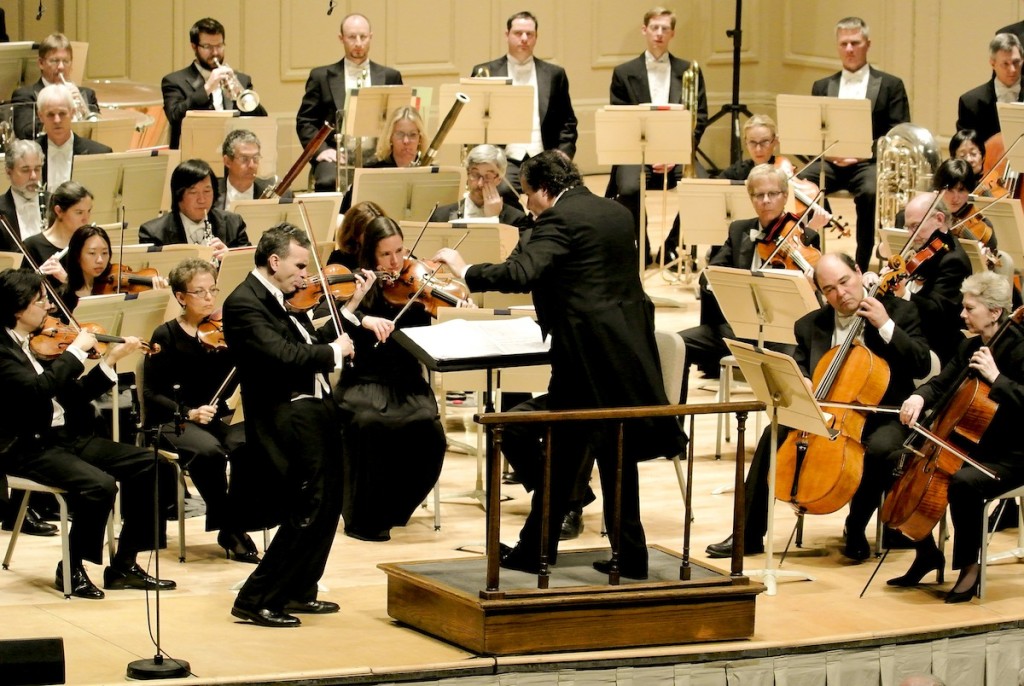Saariaho premiere and Shaham’s eloquent Britten highlight Boston Symphony program

Gil Shaham performs Britten's Violin Concerto with Juanjo Mena and the BSO Thursday night at Symphony Hall. Photo: Stu Rosner
New music—literally new, or new to many listeners’ ears—dominated Thursday night’s program by the Boston Symphony Orchestra under Juanjo Mena.
The newsmaker of the night was the American premiere of Kaija Saariaho’s Circle Map, a rich, multilayered work in six movements for orchestra and electronics commissioned by the Royal Concertgebouw Orchestra along with the BSO and orchestras in France, Scotland, Sweden, and Norway.
However, a 73-year-old piece, Britten’s Violin Concerto in a compelling performance by soloist Gil Shaham, showed it could match the new work for freshness and audience appeal.
The Saariaho work, spanning nearly a half-hour, was a major undertaking, technically and artistically. The electronic component had to be re-designed for the long rectangle that is Symphony Hall, a very different space from Amsterdam’s Westergasfabriek Gashouder, the cylindrical gas-storage-tank-turned-concert-hall for which this piece was composed.
Not only did the BSO musicians have to master the acoustical complexities of the research-based style known as musique spectrale, they then had to blend seamlessly with electronic sounds emanating from all over the auditorium.
All the effort and expense involved in mounting such a work paid off handsomely in the performance, which wove a deeply evocative sound-world around verses by the 13th-century poet Rumi, spoken on the electronic track in the original Persian.
The human voice was the work’s touchstone, first as articulate language, then as altered and abstracted sound that moved out through the hall. The sound design by Timo Kurkikangas was often such a subtle presence that one hardly knew where the musicians’ imaginative playing left off and the electronic overtones began.
All was informed by Rumi’s nature imagery, complemented by Saariaho’s chemistry with the natural acoustic properties of the instruments. For example, the work opened with a delicate sizzle of piccolo and percussion, then a microtonal swirl of strings as, in the poet’s words, “The morning wind spread its fresh smell.” In the third movement, a wonderfully strange mixture of hollow rumblings and celestial shimmer arose from Rumi’s conflicting imagery: “Walk to the well./Turn as the earth and the moon turn…”
Saariaho’s sound images could also be charmingly direct, as when a lugubrious trumpet evoked the lover’s absence in the second movement, “Walls closing,” and electronic alteration of the speaker’s voice in the fifth movement, “Dialogue,” produced a childlike squeak for a question and a voice-of-God boom for the reply.
Mena skillfully oversaw the mix of Saariaho’s acoustics and colors, giving each movement its distinct character, without neglecting a sense of pace and direction.
Big in every sense—performing forces, heart, artistic ambition—Circle Map showed a route to new territory for that old institution, the symphony orchestra.
In 1938, the 25-year-old Benjamin Britten was also looking to explore new territory, that of the English composer with an international reputation. No such animal had existed since Henry Purcell in the 17th century, but Britten’s Violin Concerto, begun that year and finished the next, showed the young composer already in command of the spare scoring and deep expression that would catch the world’s imagination six years later with the international success of Peter Grimes.
Taxing to perform and melancholy in mood, the concerto does not offer violinists an easy path to acclaim. But as Shaham, Mena, and the Boston players proved on Thursday, a vigorous and committed performance of the work can have profound effect.
Shaham’s attire—the traditional white-tie-and-tails rejected by many soloists these days in favor of more informal, hipper outfits—matched the magisterial elegance of his playing. Imperturbable in the most athletic moments, his tone was consistently sweet and clear in all dynamics, a Heifetz-like presence leavened by a charmingly un-Heifetzian tendency to grin after tossing off a particularly gnarly passage. (Heifetz himself, according to the program notes, once declared this concerto unplayable.)
The ability to project deep feeling from behind a façade of emotional reserve often seems to be a requirement for British music, and Shaham had it in abundance Thursday night.
The orchestra in this concerto is no mere prop, but an eloquent partner and antagonist. Mena and the BSO matched Shaham for accuracy, clarity, and rhythmic impulse without rushing, and made the most of their coloristic opportunities, from the soft, ominous opening for timpani and cymbal to the acidic, Russian-sounding scherzo to the long darkness-to-light crescendo of the passacaglia finale.
Shaham’s pinpoint intonation even in the highest harmonics was a particular pleasure, although it deserted him occasionally in the finale, most regrettably in the high, exposed closing measures, where the music teeters ambiguously between major and minor—a little too ambiguously, in this case.
Having apparently exhausted all their energy and rehearsal time preparing superb performances of the Saariaho and Britten works, Mena and the orchestra concluded the program with a run-through of Dvořák’s Symphony No. 7 that never came into focus. The orchestra sounded out of balance much of the time, and the work’s many attractive themes and plot twists had little impact. The audience responded to the loud, horn-whooping finish with tepid applause.
The program will be repeated Friday at 1:30 p.m. and Saturday and Tuesday at 8 p.m. bso.org. 617-266-1200.